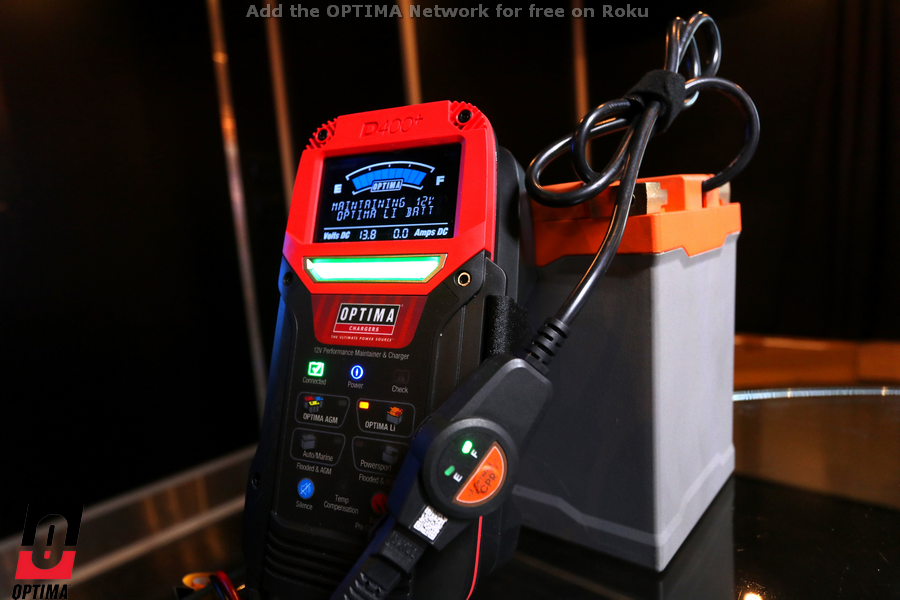Why Does My Lithium Battery Need a Special Charger?

- Sponsor
- OPTIMA Chargers
- Location
- Glendale, WI


Many battery brands and manufacturers, including OPTIMA, recommend charging lithium batteries with a charger that is specifically designed for lithium batteries or has specific charger settings for lithium batteries. In fact, it's more unusual to come across a lithium battery brand that does NOT recommend using a lithium-specific charger on their products. Why is that and why do vehicle alternators seem to have no trouble with either lithium or lead-acid batteries, but chargers have more specific requirements? We'll explain.
The typical voltage output for a vehicle alternator or charging system is somewhere in the range of about 14.4 volts, which happens to be a good voltage level for both lithium and lead-acid batteries. The concerns that are more specific to using battery chargers that are not designed for lithium batteries would include the following:
Desulfation Mode
Many chargers designed for lead-acid batteries have a desulfation mode, which can help break up sulfation on the plates of lead-acid batteries and restore some performance to them. However, when some of these chargers go into desulfation mode, even for brief periods of time, voltage output can be as high as 16 volts, which is generally not a compatible voltage level for lithium batteries.
CEC-Required Power Saving Strategies
The California Energy Commission requires that battery chargers go into a power-saving mode when the battery they are charging reaches a full state of charge. The way this often works is that the charger will go into a "sleep" mode when the battery is fully-charged, the surface charge will be allowed to dissipate and the charging cycle will resume when the battery's state of charge drops back down to about 100% state of charge. For instance, a fully-charged lead-acid battery, like an OPTIMA REDTOP may be fully-charged at about 12.6-12.8 volts, but after being charged, may have a "surface" charge of 13.2 volts.
However, when lithium batteries are fully-charged, their state of charge will be closer to 14.0 volts and lithium batteries will maintain a higher voltage level after charging, compared to the input voltage. This can cause an incompatibility issue with a charger designed for lead-acid batteries, that may not re-start until battery voltage drops to about 12.6 volts, which is less than a 10% state of charge for a lithium battery. If someone has their lithium battery in long-term storage with one of these chargers or maintainers, the battery could be connected to the charger the entire time and essentially be completely discharged.
Charger Voltage Parameters
We've mention it before, but it bears repeating- It's very important not to charge lithium batteries at too high of a voltage level. The voltage output of some battery chargers may not be compatible lithium batteries. This could result in the charging output of a lead-acid battery charger being too high for lithium batteries, which generally would stay below 15 volts in any of their charging phases.
Balancing Cell Voltage in Lithium Batteries
There needs to be an adequate amount of time for the individual cells in lithium batteries to be balanced during charging to maximize lithium battery performance and lifespan. Inadequate cell balancing can severely shorten the lifespan of lithium batteries, so it's very important that the charging time during different phases of the charging cycle for lithium batteries allows for adequate balancing of the cells within the lithium battery. Chargers with lithium-specific settings will typically make sure their charging algorithms will allow for cell balancing and the typical voltage output of vehicle charging systems will as well. However, some lead-acid battery charger manufacturers have different algorithms in place for their different charging phases, which may not be compatible with lithium batteries.
How Can You Identify a Lithium Charger?
Any charger that is either designed specifically for lithium batteries or is compatible with them, like the OPTIMA D200+ maintainer, will usually reference that functionality somewhere in their product description or packaging. If you are unsure if a battery charger or maintainer is compatible with lithium batteries, always contact the charger manufacturer for confirmation. There are dozens of different brands of battery chargers and maintainers on the market today and dozens more that are still in use, even if they are no longer being sold. That makes it very difficult for any battery brand or manufacturer to be able to keep track of all the different charger models offered by these different charger brands and the capabilities of those models.
If a charger or maintainer does not have specific settings for lithium batteries or the charger brand or manufacturer does not give you the confidence that their products are compatible with lithium batteries, keep shopping!
